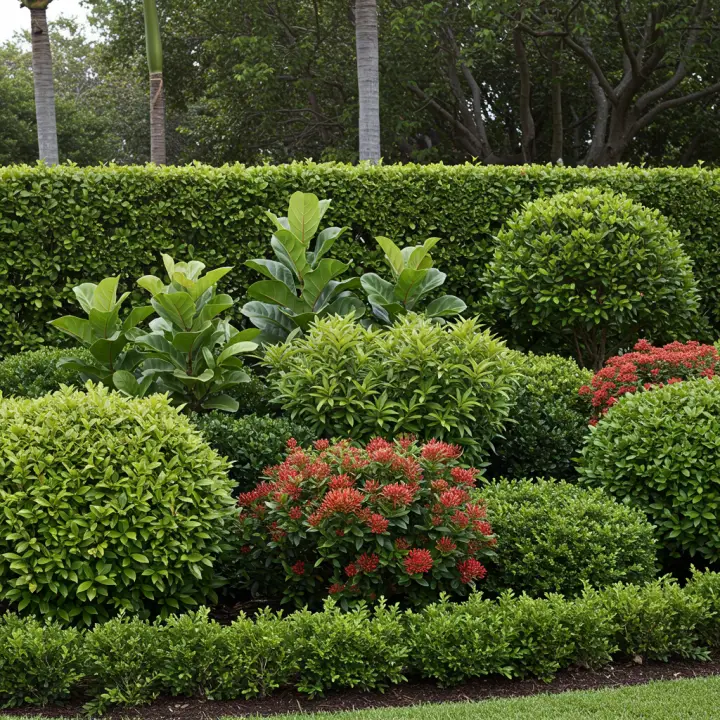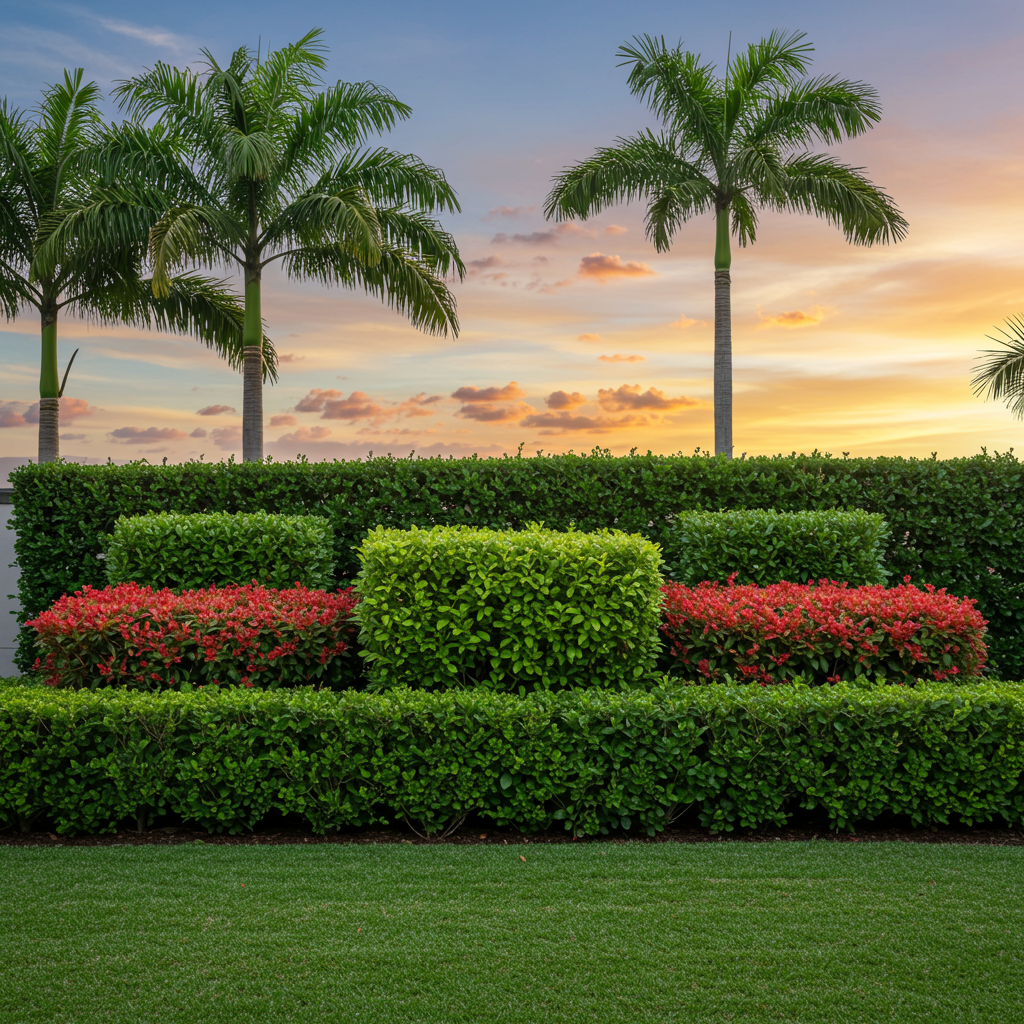Transform your West Palm landscape with the best hedge plants designed for effortless beauty and robust growth. This guide covers top-performing, low-maintenance varieties perfect for privacy, vibrant aesthetics, and thriving in Florida’s unique climate.
Creating a lush, vibrant, and private outdoor space in West Palm Beach is a dream for many homeowners. Hedges are an excellent way to define property lines, block unwanted views, reduce noise, and add significant curb appeal. But with Florida’s specific climate – intense sun, humidity, and sometimes drought conditions – choosing the right plants is crucial for success. This guide will walk you through the top-performing, effortless hedge plants that not only survive but thrive in West Palm, ensuring your landscape remains stunning with minimal fuss
.
Why Choose the Right Hedge Plants for West Palm?
Selecting the perfect hedge plant isn’t just about aesthetics; it’s about making an informed choice that considers your local environment.
Climate Considerations
West Palm Beach boasts a tropical to subtropical climate, characterized by warm temperatures year-round, high humidity, and distinct wet and dry seasons. Plants must be able to tolerate intense sun, occasional strong winds, and varying rainfall without constant intervention. Choosing plants adapted to these conditions minimizes stress on both the plant and the gardener.
Privacy and Aesthetics
Beyond practicality, hedges significantly enhance your home’s beauty. They provide a green backdrop, can be shaped into formal lines, or allowed to grow into natural, flowing forms. A well-chosen hedge offers immediate privacy, creating a secluded oasis for relaxation and family gatherings.
Low Maintenance Appeal
Let’s face it, most of us want a beautiful garden without it becoming a full-time job. “Effortless” is key. The best hedge plants for West Palm are those that require minimal watering once established, resist common pests and diseases, and only need infrequent pruning to maintain their shape and health.
Top Picks: Best Hedge Plants for West Palm Beach
Here are some of the most reliable and beautiful hedge plants that flourish in West Palm’s climate, offering a blend of privacy, beauty, and ease of care.
Florida-Friendly & Drought-Tolerant Options
These plants are champions at handling the local conditions with grace.
Green Island Ficus ( Ficus microcarpa ‘Green Island’):
Why it’s great: This ficus variety is much more manageable than its larger cousins. It features glossy, dark green leaves and a dense growth habit, making it superb for privacy screens. It’s relatively slow-growing, reducing pruning needs, and highly drought-tolerant once established.
Ideal for: Formal hedges, moderate privacy.
Podocarpus ( Podocarpus macrophyllus):
Why it’s great: A classic for Florida hedges, Podocarpus offers a fine-textured, upright growth. Its slender, dark green leaves give a sophisticated look, and it’s incredibly versatile regarding sun exposure (full sun to partial shade). It can be pruned into tight, formal hedges or left more natural.
Ideal for: Formal hedges, tall privacy screens.
Viburnum ( Viburnum odoratissimum ‘Awabuki’):
Why it’s great: The ‘Awabuki’ cultivar is celebrated for its large, tropical-looking, dark green, shiny leaves and upright growth. It’s fast-growing, creating a dense screen quickly, and produces small white flowers followed by red berries. It tolerates a range of soils and sun conditions.
Ideal for: Fast privacy, dense screening.
Clusia ( Clusia rosea ‘Nana’):
Why it’s great: Often called the “Autograph Tree,” Clusia is incredibly robust with thick, paddle-shaped leaves. The dwarf variety (‘Nana’) is excellent for hedges, offering extreme drought and salt tolerance, making it perfect for coastal West Palm areas. It’s slow-growing and requires minimal care.
Ideal for: Coastal areas, low to medium hedges, modern landscapes.
Colorful & Flowering Choices for Impact
Bring bursts of color and texture to your hedge line.
Ixora ( Ixora coccinea):
Why it’s great: For vibrant pops of color, Ixora is unrivaled. It produces clusters of red, orange, yellow, or pink flowers almost year-round. It prefers full sun and well-drained, acidic soil. While it requires a bit more attention to pruning to maintain a formal hedge shape, its continuous bloom is worth it.
Ideal for: Low to medium flowering hedges, accent planting.
Copperleaf ( Acalypha wilkesiana):
Why it’s great: If you want foliage that looks like flowers, Copperleaf is your plant. Its leaves come in an incredible array of colors – bronze, red, pink, and green – often variegated. It’s fast-growing and creates a vibrant, informal hedge. Needs full sun for the best color.
Ideal for: Informal, colorful hedges.
Oleander ( Nerium oleander):
Why it’s great: Oleander is incredibly tough, thriving in heat, drought, and even poor soil. It produces abundant pink, white, or red flowers through much of the year. Caution: All parts of the oleander plant are highly toxic if ingested, so plant away from pets and children.
Ideal for: Tough, drought-tolerant, flowering hedges (with caution).
Rapid Growth for Quick Privacy
When you need a screen fast, these options deliver.
Areca Palm ( Dypsis lutescens):
Why it’s great: While technically a palm, Arecas are frequently planted in dense rows to form attractive, tropical-looking privacy screens. They grow relatively fast, especially with adequate water and fertilizer, and provide an instant tropical feel. They prefer partial shade but can adapt to full sun with enough moisture.
Ideal for: Tropical privacy screens, softening architectural lines.
Giant Timber Bamboo (Non-Invasive Types like Bambusa multiplex ‘Alphonse Karr’):
Why it’s great: For the fastest privacy screen, clumping bamboo varieties like ‘Alphonse Karr’ are excellent. They grow incredibly quickly and form a dense, lush screen. Important: Always choose clumping varieties, not running ones, to avoid invasive spread.
Ideal for: Very fast privacy, exotic screens.
Factors to Consider When Selecting Your West Palm Hedge
Making the best choice involves more than just liking the look of a plant.
Mature Size and Spread
Always consider how large your chosen plant will get. A plant that grows 10-15 feet tall might be perfect for a tall privacy hedge but overkill for a low border. Account for its spread to ensure proper spacing and prevent overcrowding.
Sun Exposure Needs
Does your hedge line receive full sun (6+ hours per day), partial sun (3-6 hours), or shade (less than 3 hours)? Matching the plant’s needs to your site’s conditions is fundamental for its health.
Soil Requirements
While many Florida plants are adaptable, well-draining soil is almost universally preferred. If you have very sandy or heavy clay soil, consider amending it with organic matter to improve drainage and nutrient retention.
Water and Drought Tolerance
Once established, many of the recommended plants are highly drought-tolerant, meaning they can survive on natural rainfall. However, during their establishment period (the first 6-12 months after planting), regular watering is crucial.
Pest and Disease Resistance
Opting for plants known for their natural resistance to local pests and diseases will save you time, effort, and money on treatments. Florida-friendly plants are often naturally more resilient.
Maintenance Level (Pruning, Fertilizing)
How much time are you willing to dedicate to your hedge? Some plants like Ixoras or Copperleaf will need more frequent pruning to stay tidy, while a Clusia or Green Island Ficus is more forgiving.
Effortless Hedge Plant Care in West Palm
Even “effortless” plants benefit from good initial care and a simple maintenance routine.
Initial Planting Tips
Dig a Wide Hole: Make the hole at least twice as wide as the root ball, but no deeper.
Water Thoroughly: Water the plant in its container before planting and deeply after planting.
Mulch: Apply a 2-3 inch layer of organic mulch (like pine bark or cypress mulch) around the base of the plants, keeping it a few inches away from the trunk. Mulch helps retain moisture, regulate soil temperature, and suppress weeds.
Watering Schedule
Establishment Period: Water daily or every other day for the first few weeks, then gradually reduce frequency as the plant establishes. The goal is consistent moisture, not soggy soil.
Established Plants: Most West Palm hedges, once established, will thrive on natural rainfall. Water during extended dry periods, especially if leaves show signs of wilting.
Fertilization
Use a slow-release granular fertilizer specifically formulated for tropical shrubs. Fertilize in late winter/early spring and again in late summer. Follow package directions carefully to avoid over-fertilizing.
Pruning for Shape and Health
Initial Pruning: Lightly prune after planting to encourage branching.
* Maintenance Pruning: Regular, light pruning helps maintain the desired shape and density. Avoid heavy pruning in late fall or winter, as new growth can be damaged by any unexpected cold snaps. For a formal hedge, prune more frequently. For a natural look, prune less often, focusing on removing dead or crossing branches.
FAQs About West Palm Hedge Plants
What are the fastest-growing hedge plants for West Palm?
For extremely fast growth, clumping bamboo varieties like ‘Alphonse Karr’ are exceptional. Areca Palms and Viburnum ‘Awabuki’ also offer rapid growth for quick privacy.
Which hedge plants are best for privacy in West Palm?
Green Island Ficus, Podocarpus, and Viburnum ‘Awabuki’ are excellent choices for dense privacy screens. Areca Palms also create a good visual barrier.
Do I need to fertilize my hedge plants in Florida often?
Typically, one to two applications per year of a slow-release granular fertilizer formulated for tropical shrubs (in spring and late summer) are sufficient to maintain healthy growth.
Are there any salt-tolerant hedge plants for coastal West Palm areas?
Yes! Clusia ‘Nana’ is incredibly salt-tolerant and an excellent choice for coastal properties. Oleander is also highly tolerant of salt spray.
How wide should I plant hedge plants for a dense screen?
Spacing depends on the mature spread of the plant. A general rule of thumb is to plant them at a distance equal to about two-thirds of their mature spread. For example, if a plant spreads 3 feet, plant them 2 feet apart to create a dense, interlocking hedge. Always check specific plant tags for recommended spacing.
Conclusion: Your Green Oasis Awaits
Choosing the best hedge plants for West Palm doesn’t have to be a daunting task. By selecting varieties well-suited to Florida’s climate and providing a little initial care, you can create a beautiful, private, and effortless landscape feature that enhances your home for years to come. Whether you desire a formal green wall, a vibrant flowering screen, or a lush tropical barrier, the perfect hedge plant is waiting for you to discover and enjoy. Get ready to cultivate your own West Palm oasis!

